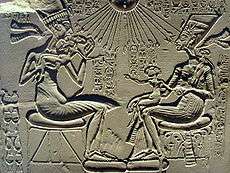Nakhtpaaten
| Nakhtpaaten (Nakht) Vizier | |
|---|---|
| Predecessor | Ramose |
| Successor | Usermontu? |
| Dynasty | 18th Dynasty |
| Pharaoh | Akhenaten |
| Burial | Tomb no.12 in Amarna |
| |||||
| Nakhtpaaten[1] in hieroglyphs |
|---|
Nakhtpaaten (“Strong is the Aten”) or Nakht was an ancient Egyptian vizier during the reign of Pharaoh Akhenaten of the 18th dynasty.
Biography
Nakhtpaaten seems to have succeeded the Vizier Ramose in office. Ramose was the vizier in Thebes possibly up to the time of the move to Akhetaten, Akhenaten's new capitol. Ramose's tomb in Thebes was not finished and after the move to the new city in year 4-5 of Akhenaten Nakhtpaaten is the vizier. His titles as given in his house and tomb were: Hereditary prince, count, sealbearer, overseer of the city and vizier, overseer of the work projects in Akhet-Aten.[2]
It is likely Nakhtpaaten who is depicted in the tomb of Mahu who served as the Chief of Police. Mahu is shown meeting with a vizier and a lesser official named Heqanefer in a scene related to policing the city.[3] Mahu leads three individuals before the vizier, two of whom are bearded. These men appear to have been accused of trespassing in the desert area surrounding Amarna. [4]
Residence
He lived in the southern city part of Akhet-Aten, his house has been found.[5] The house was located to the far southern parts of the city and quite far removed from the palace. Nakht must have traveled daily to the central part of the city to fulfill his office.[4]
Nakhtpaaten's house was a large mansion which included reception halls, bedrooms, a bathroom, a lavatory and offices.[6]
The house has been described extensively by for instance Woolley back in 1922. A set of stairs lead to a set of small entry rooms. Beyond there smaller rooms was a large room referred to as a loggia. It's a large open covered space, open on the side. The walls were white washed, and colors were used to accent the space. The ceiling in the loggia was painted deep blue. [4][7]
The central space of the building was a pillared hall and the main reception area of the house. It measures about 8 meters square. On one side of the room a brick divan stretched almost the entire length of the wall. The ceilings were high and indirect light was filtered into the space. [7]
The reception area opened up into another loggia with large open windows on one side, and it may have been a space used in the winter when the sun would have warmed this area. This space was decorated with a scene showing Akhenaten adoring the cartouches of the Aten. Another niche mentions the titles of Nakht and had the Hymn to the Aten inscribed.[7]
Off the main hall, but on another wall was an entrance to another reception room. This was a more private space than the larger reception room mentioned above. Nearby were the bedrooms of the Vizier and his wife. Adjacent to the bedrooms were rooms that used as the bathroom and the lavatory. The bath was placed on a raised platform and stairs were constructed so that the servants could poor water over the bather. [7]
Tomb
His tomb was Tomb no. 12 of the Amarna rock tombs.[8] Only the facade and the entrance way were completed for this tomb. There are beginnings of three columns in the main hall, but the tomb never proceeded much past this stage. [3]
References
- ↑ Hermann Ranke: Die ägyptische Persönennamen. Verlag von J. J. Augustin in Glückstadt, 1935, p.210
- ↑ Murnane, William J, Texts from the Amarna Period in Egypt, Society of Biblical Literature, 1995 ISBN 1-55540-966-0
- 1 2 N. de G. Davies, The rock tombs of El-Amarna, Parts III and IV, 1905 (Reprinted 2004), The Egypt Exploration Society, ISBN 0-85698-160-5
- 1 2 3 Kemp, Barry, The City of Akhenaten and Nefertiti: Amarna and its People, Thames and Hudson, 2012
- ↑ Nicholas Reeves: Akhenaten – Egypt’s False Prophet. London, Thames & Hudson, 2005. ISBN 0-500-28552-7, p.126
- ↑ Aldred, Cyril, Akhenaten: King of Egypt ,Thames and Hudson, 1991 (paperback), ISBN 0-500-27621-8
- 1 2 3 4 Woolley, C. Leonard, Excavations at Tell el-Amarna, The Journal of Egyptian Archaeology, Vol. 8, No. 1/2 (Apr., 1922), pp. 48-82
- ↑ Reeves, op.cit, p.136
